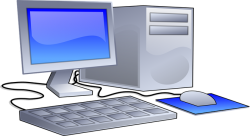 It is not an easy job to identify why your computer is failing. It could be a hardware problem or a software issue. If you believe that your computer is failing because of a hardware problem, then the next thing to do is to find the device that is causing the problem. Here, we discuss some common hardware problems and steps to identify it.
It is not an easy job to identify why your computer is failing. It could be a hardware problem or a software issue. If you believe that your computer is failing because of a hardware problem, then the next thing to do is to find the device that is causing the problem. Here, we discuss some common hardware problems and steps to identify it.
Steps to Identify Why Your Computer is Failing
- Blue Screen: If your computer is displaying a blue screen when restarting, then you should identify the error messages displayed on the screen. As a user, you should keep in mind that most of the blue screen error messages are related to hardware faults. It is also known as the “Death Screen.” However, it shows messages that are related to the hardware that is causing the error that causes it to appear.
- Checking the status of the Hard Drive: Hard drives usually have an in-built SMART feature, i.e., Self-monitoring, Analysis and Reporting Technology. A hard disk monitors its own performance, and if it shows symptoms of failure, it warns you in advance. When SMART shows warning messages, you can utilize the Smart Analysis tool to do a health checkup. You can view the messages displayed by SMART and learn what is causing an issue, so that you can take the necessary steps to fix it.
- Testing your RAM: Another way to identify why your computer is failing is by testing your RAM. A RAM failure can cause a lot of issues. When the computer writes data to RAM and when the RAM displays a different set of data, then it is a sign of a malfunctioning RAM. This malfunctioning of RAM can cause issues like system crashes, blue screen and application crashes. To identify if your computer is failing because of RAM failure, you need to test the RAM. With Windows, you can use the in-built Windows tool “Memory Diagnostic,” to test the performance of RAM. The program will write data to the RAM and then retrieve it to see if it matches. If not, it may be time to buy a new RAM.
- Checking the Heat Level: Another way to identify why your computer is failing is by checking the heat level. Overheating can cause severe damage to your system. Blue screens, regular shutdowns, and system crashes are all signs of overheating. By going to the BIOS, you can view the information. You need to check the system’s temperature level to verify it is inside the allowed range.
- Checking the performance of the CPU: Checking the performance of the CPU is another way to identify why your computer is failing. Using a utility like “Prime 95,” you can perform a stress test to see if it is working correctly. If there are any issues with the CPU, it will provide errors messages.
- Graphic Card: Another part that can cause an error is the graphic card. You can test the graphic card performance by using a utility like 3DMark. It will check if your graphic card is overheating and causing any issues that are causing your computer to fail.
Conclusion
There could be many reasons why your computer is failing. You need to test each area to find where the problem is stemming from. The points discussed above will definitely help you to identify why your computer is failing so that you can take corrective actions.

 Email article
Email article



